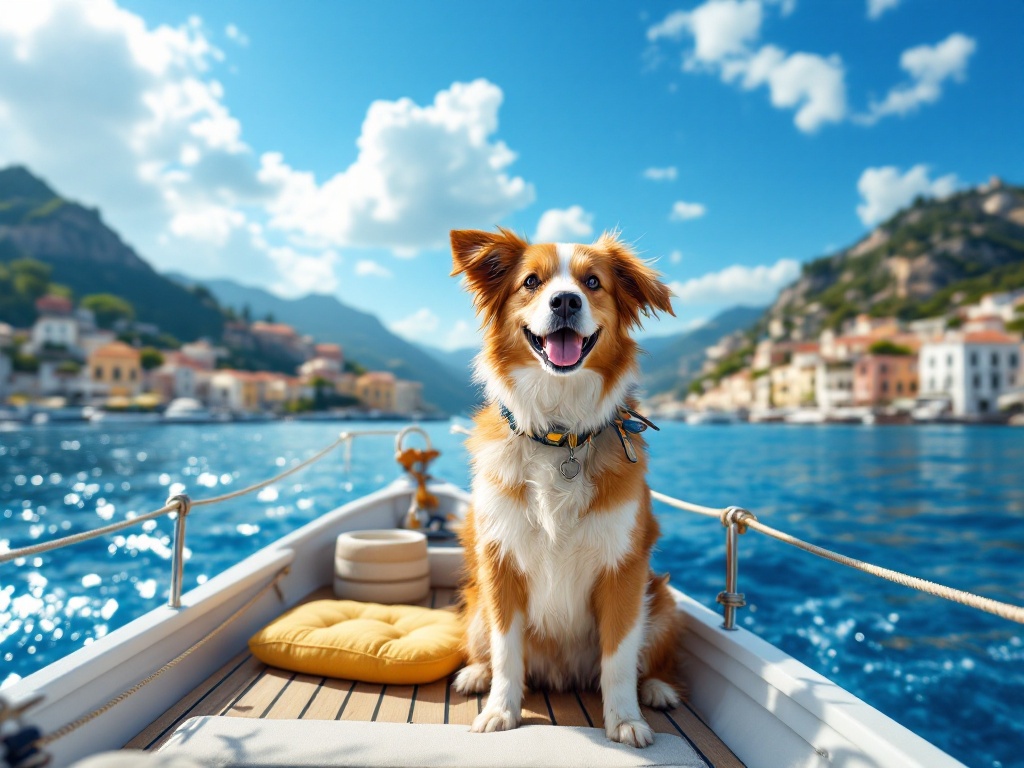How to Travel to Europe by Boat with a Dog: Best Tips
Sailing to Europe with your dog? Smooth sailing requires careful planning. This guide covers essential travel regulations, including pet passports, microchips, and vaccinations. Discover pet-friendly cruise lines like Cunard and P&O Cruises, and learn how to navigate customs procedures. Explore tips for managing seasickness and finding dog-friendly accommodations. Start planning your unforgettable European adventure today!
Important information

- Research your destination country’s specific pet import rules, including vaccination, microchip, and paperwork needs.
- Secure a pet passport, health certificate, and proof of rabies vaccination. Check for breed restrictions and quarantine rules.
- Book with a pet-friendly shipping line like Cunard (Queen Mary 2 offers kennels and a dog-walking area) or Brittany Ferries/DFDS (limited transatlantic pet cabin options).
- Pack essentials: food, medication, absorbent materials, familiar items (bed, toys), and a pet first-aid kit.
- Upon arrival, have customs documents ready and supervise your dog in unfamiliar port environments. Reserve dog-friendly accommodations and locate suitable beaches beforehand.
Preparing for a Boat Trip to Europe with Your Dog
Planning a European cruise with your dog? Review current travel regulations for a smooth trip.
Understanding Travel Regulations and Requirements
Traveling to Europe with your pet? Regulations vary by country, so research your destination’s specific requirements. Essential paperwork often includes a pet passport, a health certificate, and proof of rabies vaccination. Microchipping is also typically required. Be aware that some countries impose quarantine periods. Others, like the UK, mandate a tapeworm treatment. Certain breeds may also face restrictions. For the latest details, consult the official government websites of the countries you plan to visit.
Research your destination’s specific pet import requirements. Regulations vary significantly across European countries.
Obtain a pet passport. This document is essential for international pet travel within Europe.
Ensure your pet has a valid health certificate. This certificate must be issued by an accredited veterinarian.
Confirm your pet’s rabies vaccination is up-to-date. Some countries may require a rabies titer test.
Have your pet microchipped. This is a standard requirement for pet travel in most European countries.
Be aware of potential quarantine periods. Some countries may require your pet to undergo a quarantine period upon arrival.
Check for specific requirements like tapeworm treatment. The UK, for example, mandates tapeworm treatment for entering pets.
Research breed restrictions. Certain breeds may be prohibited or face specific entry requirements in some countries.
Pet Import Permits and Health Certificates
Traveling to Europe with your dog requires an import permit and a health certificate. Research your destination country’s specific regulations, as they often mandate microchipping and rabies vaccinations. Additional health checks may also be necessary. Ensure your dog’s health certificate is current and complies with EU regulations.
European Pet Passport and Vaccinations
Traveling to Europe with your pet? A European pet passport is essential for a smooth trip. Ensure your dog’s rabies vaccination is up-to-date and properly documented in the passport. Microchipping your pet is highly recommended for added security. Because specific regulations vary by country, research your destination’s requirements beforehand to avoid any surprises.
Choosing the Right Boat for Transatlantic Travel with a Dog
Planning a transatlantic voyage with your dog? Several pet-friendly shipping lines offer various options. However, the rules vary between companies, so it’s important to research carefully before booking.
Cunard and P&O Cruises
These lines offer dedicated kennels on select transatlantic crossings. The Queen Mary 2 even provides a dedicated dog-walking area and a kennel master.
Brittany Ferries and DFDS
While these companies allow dogs onboard, cabins are typically unavailable for pets during transatlantic voyages. Brittany Ferries offers cabins for dogs on certain routes, but not on transatlantic crossings.
Before booking, consider the kennel size, available exercise space, and the ship’s specific pet policies to ensure a comfortable trip for you and your pet.
Exploring Pet-Friendly Shipping Lines
Planning a sea voyage with your beloved pet? Cunard and P&O Cruises extend a warm welcome to furry companions. However, securing the ideal trip requires careful preparation. Follow these steps to ensure a smooth and enjoyable experience for both you and your pet:
Explore ferry options online. Research various ferry companies and compare their services, routes, and prices.
Scrutinize pet policies. Carefully review each company’s specific regulations regarding pets, including size restrictions, breed limitations, required documentation, and any associated fees.
Read pet owner reviews. Learn from the experiences of others who have traveled with their pets. Look for insights into the pet-friendliness of specific ferries, accommodations, and onboard facilities.
Reserve pet-friendly accommodations early. Secure your preferred cabin or designated pet area well in advance, as availability is often limited, especially during peak season.
Prioritize vessels with outdoor decks. Choose a ferry that offers designated outdoor spaces where your pet can enjoy fresh air, exercise, and a change of scenery.
Traveling by Cruise Boat: Options and Considerations
Sail with your pet to Europe on the Queen Mary 2, the only Cunard liner offering transatlantic crossings for pets. Contact Cunard for information on pet policies, cabin availability, and suitable accommodations. When planning your trip, consider pet-friendly cabins and designated outdoor areas. Also, factor in your pet’s temperament and potential travel anxieties. Some pets adapt easily to sea voyages, while others may find the ship’s environment stressful. Before booking, ensure you understand all international pet travel requirements.
Onboard Accommodations for Dogs
Traveling with your pet by ferry or cruise? Many companies offer pet-friendly cabins for a comfortable journey. Some vessels also feature designated pet areas for socializing and play, and some even have outdoor exercise spaces. Note that these amenities vary by route and kennel services may be limited. For complex pet travel arrangements, consider a pet relocation service to manage logistics and ensure a stress-free trip.
Pet-Friendly Cabins and Outdoor Seating
Traveling with your pet can be a breeze with many ferry and cruise lines offering pet-friendly accommodations. Several companies provide convenient amenities like dog beds, bowls, and waste bags, ensuring a comfortable journey for your furry companion. Some vessels even feature designated outdoor pet relief areas where pets can exercise and take potty breaks. However, pet policies vary among operators, so it’s always best to confirm directly with the company you plan to travel with. European ferry operators such as Brittany Ferries, DFDS, and Stena Line are known for their pet-friendly options. While some cruise lines like Royal Caribbean and Cunard allow service animals, their policies on other pets may differ, so it’s crucial to inquire beforehand.
Ensuring Comfort with Kennel and Pet Relocation Services
Pet relocation services specialize in the safe and comfortable transport of animals, prioritizing their well-being throughout the journey. These services typically offer climate-controlled transport and cozy kennels, overseen by experienced handlers. Many also include exercise breaks, regular feeding schedules, and health monitoring to minimize stress and ensure comfort. Bringing familiar items can further enhance your pet’s relaxation and reduce anxiety by providing a sense of security during travel. Some recommended items include your pet’s bed, toys, or even a crate if they are crate-trained.
Essential Supplies and Travel Preparation
- Pack enough food for your dog’s entire journey.
- Don’t forget any essential medications your dog needs.
- Bring absorbent materials like pee pads for accidents.
- Pack familiar items, such as your dog’s bed or favorite toys, to provide comfort and reduce travel anxiety.
- A pet first-aid kit is recommended for dealing with minor injuries or ailments.
Food, Medications, and Absorbent Materials for Dogs
Pack absorbent bedding, ample food, and any necessary medications for your dog’s carrier.
Include food and water bowls, a leash, and waste bags.
Pack grooming supplies to keep your dog looking their best.
Bring a comfortable bed or blanket and some engaging toys to make the journey more enjoyable.
A pet first-aid kit is crucial for any unforeseen circumstances.
Remember your dog’s health certificates and vaccination records.
Managing Motion Sickness and Separation Anxiety
Introduce your dog to boating gradually with short, introductory trips to minimize anxiety and help them acclimate. For dogs prone to seasickness or nervousness, consider calming aids such as pheromones or medication (consult your veterinarian). Pack familiar toys and bedding to provide comfort and reduce stress. Maintaining a consistent routine can also help alleviate anxiety.
Arriving in Europe: Navigating Customs and Beyond
Traveling to Europe with your dog? Ensure a smooth trip by preparing the necessary customs documents. Inspections can occur at various entry points, so have your paperwork ready. Research your destination country’s specific rules regarding vaccinations, microchips, and health certificates. Having these documents readily available will expedite customs clearance. Consider your dog’s comfort in new environments. Pre-book dog-friendly accommodations and locate dog-friendly beaches. Careful planning will guarantee a pleasant European vacation for both of you.
Research Destination-Specific Regulations. Investigate your destination country’s requirements for vaccinations, microchips, and health certificates.
Prepare Customs Paperwork. Gather all necessary customs documents for your dog to ensure smooth travels.
Consider Your Dog’s Comfort. Think about your dog’s comfort levels in unfamiliar environments.
Book Dog-Friendly Accommodations. Research and reserve accommodations that welcome dogs in advance.
Locate Dog-Friendly Beaches. Find dog-friendly beaches and other recreational areas for your furry friend.
Customs Paperwork and Supervision in Unfamiliar Surroundings
Before arriving at the port, ensure you have your dog’s health certificates and vaccination records readily available, as customs officials may require them. Upon arrival at the port, maintain close supervision of your dog due to the unfamiliar and potentially disorienting environment.
Finding Dog-Friendly Accommodations and Beaches
Planning a European getaway with your canine companion? Here’s how to make it paw-sible:
Research and Prepare
Start your adventure by exploring dog-friendly accommodations and beaches online. Specialized pet travel websites and apps can be invaluable resources. Confirm pet policies, fees, and amenities directly with your chosen accommodation.
Beach Regulations
Research local beach regulations in advance. Some beaches may have restrictions or designated dog-friendly zones, including specific hours for dogs. Direct confirmation will ensure a smooth arrival and a happy pup.














